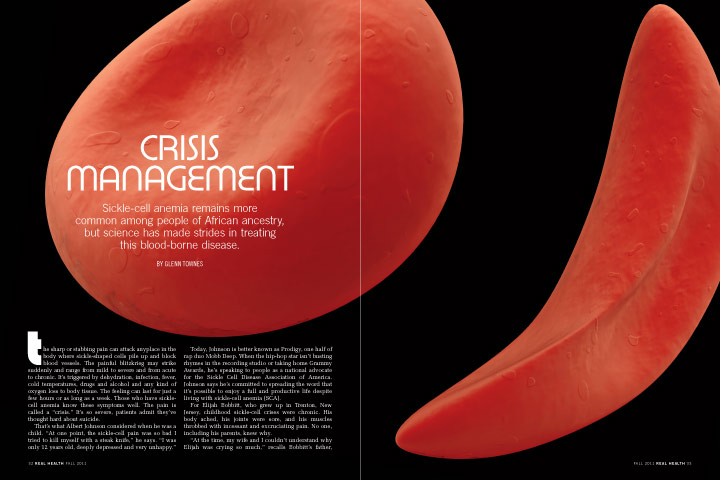
<br,br>
The sharp or stabbing pain can attack anyplace in the body where sickle-shaped cells pile up and block blood vessels. The painful blitzkrieg may strike suddenly and range from mild to severe and from acute to chronic. It’s triggered by dehydration, infection, fever, cold temperatures, drugs and alcohol and any kind of oxygen loss to body tissue. The feeling can last for just a few hours or as long as a week. Those who have sickle-cell anemia know these symptoms well. The pain is called a “crisis.” It’s so severe, patients admit they’ve thought hard about suicide.
That’s what Albert Johnson considered when he was a child. “At one point, the sickle-cell pain was so bad I tried to kill myself with a steak knife,” he says. “I was only 12 years old, deeply depressed and very unhappy.”
Today, Johnson is better known as Prodigy, one half of rap duo Mobb Deep. When the hip-hop star isn’t busting rhymes in the recording studio or taking home Grammy Awards, he’s speaking to people as a national advocate for the Sickle Cell Disease Association of America. Johnson says he’s committed to spreading the word that it’s possible to enjoy a full and productive life despite living with sickle-cell anemia (SCA).
For Elijah Bobbitt, who grew up in Trenton, New Jersey, childhood sickle-cell crises were chronic. His body ached, his joints were sore, and his muscles throbbed with incessant and excruciating pain. No one, including his parents, knew why.
“At the time, my wife and I couldn’t understand why Elijah was crying so much,” recalls Bobbitt’s father, Andrew. “We constantly took him to various doctors and hospitals. No one could tell us what was wrong with our child.”
Finally, after a litany of tests, including lab work, X-rays and a lot of poking and prodding, doctors diagnosed Bobbitt with SCA at age 4. “I didn’t know anything about sickle-cell anemia,” says Bobbitt, now 21. “All I knew was that I was always in a lot of pain and felt sick all the time.”
What Bobbitt didn’t know then was that he’d received sickle hemoglobin genes—a.k.a. sickle-cell trait genes—from each parent. (Hemoglobin is a protein molecule in red blood cells that carries oxygen from the lungs to the body’s tissues and then returns carbon dioxide from the tissues to the lungs. It also helps red blood cells maintain their healthy round shape.)
Sickle hemoglobin genes can cause red blood cells to become crescent-shaped and sticky. The abnormal shape and stickiness stop the cells from properly flowing through the blood vessels of limbs and organs. The result? Pain, serious infections and organ damage.
When both parents pass these abnormal genes to their baby, the child is very likely to develop sickle-cell anemia, a specific and common type of sickle-cell disease (SCD). This genetically inherited blood disorder affects about 100,000 Americans, according to the Centers for Disease Control and Prevention. What’s more, one out of every 500 African Americans develop the potentially fatal condition.
Currently, sickle-cell screening of newborns is mandated in all 50 states. However, when Bobbitt was born in April 1990, there was no newborn screening test. Besides, his parents weren’t aware of their son’s heightened risk: “My wife and I didn’t even know we were carriers of the trait until after Elijah was diagnosed,” his father explains. “That’s when we started intensively educating ourselves about the disease.”
After Bobbitt’s diagnosis, his parents entered counseling and learned about available SCD medications and children’s treatment options. But each time Bobbitt required treatment, his father had to trek miles to either Philadelphia or New Brunswick, New Jersey, and spend the night at a hotel near the hospital where his son was being treated. The reason? Trenton had no treatment facilities for people with sickle cell. “The entire situation put a financial and emotional strain on our family,” the elder Bobbitt shares. “There was very little awareness about sickle-cell anemia in Trenton. Believe it or not, a lot of people knew little if anything about the disease.”
Even among some doctors today, ignorance of SCD remains. “There is a significant need for public awareness about sickle-cell anemia and for funding to support research into treatment options and supportive care for those affected by SCA,” says Ifeyinwa Osunkwo, MD, a pediatric hematologist at Aflac Cancer Center of Children’s Healthcare of Atlanta. “The majority of America is unaware of what SCA is, how it is inherited and what complications it can cause.”
For starters, because African Americans are more likely to get SCD, it’s often ignored that other races can also develop the condition. “Most Americans with SCA have African ancestry, but the disease also affects Hispanics and occasionally Caucasians,” says John Cunningham, MD, director of the sickle- cell disease program at La Rabida Children’s Hospital in Chicago. “Worldwide, SCA affects persons from North, Central and South America, the Mediterranean region, India and Africa.”
Many people also don’t know that treatment is key to avoiding complications stemming from sickle-cell disease. Unfortunately, treatment is often long-term, and issues of affordability and costs arise. In Bobbitt’s case, the bulk of his medical treatments were covered under his father’s health insurance. But for many people living with sickle-cell disease, access to care is not so readily available. “Even though we have effective treatment options for sickle-cell anemia, adults who do not have insurance cannot access this care,” Osunkwo says.
One of the effective treatment options that excite Osunkwo is the controversial bone marrow transplant that some doctors regard as a cure for SCD. If successful, bone marrow transplants can eliminate sickle cell, Osunkwo says.
But other physicians, such as Carole Kenner, DNS, PhD, dean of the School of Nursing and associate dean of the Bouvé College of Health Sciences at Northeastern University of Boston, say bone marrow transplants may merely put sickle cell in remission and only cure the disease in very rare instances.
Nevertheless, apart from the controversy, doctors agree that federal, state and local governments need to do more to offer SCD patients affordable treatment options. Although SCD bone marrow transplants are considered a standard care option and are fully covered by many insurance carriers, including Medicaid (if patients meet state-imposed eligibility requirements), they are extremely expensive. What’s more, the procedure is very high-risk for adults, and there are few available bone marrow donor matches for African Americans.
Perhaps this is why Kenner and other doctors stress the three traditional treatment management options for sickle-cell anemia: comprehensive care, the use of meds such as hydroxyurea and penicillin (prescribed to babies with sickle cell from 2 months to 5 years old), and red blood cell transfusions (of temporary benefit).
But lifestyle modifications also help treat and manage SCD symptoms and shouldn’t be overlooked, Osunkwo says. For example, after Prodigy agreed to his mother’s suggestion to go into counseling, at age 12, the therapy he received helped him change his lifestyle so he could better manage living with SCA. As he got older and educated himself even more about the condition, Prodigy learned the importance of healthy living as a way to control SCA.
“I drink water like a fish and just eat nutritious foods,” Prodigy says. “I notice that since I’ve been doing that for the past seven to eight years, I don’t get sick as much as I used to. And if I do get sick, it’s really because of something I’m doing wrong. I really know my body and how to control the disease.”
To regulate his SCA, Bobbitt normally visits the hospital once each week to monitor his blood cells. In addition, each day, he swallows several medications and supplements as part of a customized treatment cocktail.
Osunkwo says the medical community must do more to improve health outcomes for SCA patients. For starters, this includes: increased SCA education in medical schools and other paraprofessional fields; ongoing education to emergency room providers and hospital care personnel about how to manage SCA patients with acute complications; better ways to transfer medical information to keep patient care consistent; and more research into pain management and other related sickle-cell complications.
To optimize health outcomes, Osunkwo says, everyone must understand that SCA therapy needs a comprehensive approach: disease management, self-efficacy and quality-of-life improvements, not just a pill to make pain go away.
But even though there’s more to be done, science has made great strides. Now, the childhood mortality rate for those with SCA is almost zero. Today, people with sickle-cell disease live well into their 40s and beyond. Compare this with the sickle-cell prognosis in 1973. That’s when doctors estimated the median survival age for kids with the condition was about 14.
The good news is, more adults are living with the condition. But that’s created other problems. “Currently, there’s a serious deficit in providers to care for these aging patients,” Osunkwo explains.
Ultimately, doctors hope to stop SCD by changing or replacing the abnormal gene that causes it. “Research is looking into gene therapy as an alternative way to cure the disease,” Osunkwo explains. “But we are still several years away from administering a clinical application of this treatment.”
In the meantime, people like Prodigy and Elijah Bobbitt refuse to let living with SCD get them down. Prodigy launched a “No Pain” campaign earlier this year to raise awareness about the disease. Bobbitt focuses on day-to-day optimism. “Maybe one day there will be an [easy, effective and affordable] cure for it,” he says.
Until then, Bobbitt suggests SCD patients stay mentally positive. His advice? “Never lose hope.”
Sports Bar
Should having sickle-cell trait make student athletes ineligible for competition?
No, says the National Collegiate Athletic Association (NCAA). But the sports body did recommend member colleges and universities screen student-athletes—particularly football players—for sickle-cell trait.
Why? Because since 2000, student-athletes with sickle-cell trait have collapsed and died more often than their counterparts with other conditions, the NCAA says.
The reason this can happen is because during intense training, normal red blood cells can suddenly become sickle shaped and trigger a life-threatening medical condition called exertional rhabdomyolysis. When student-athletes with sickle-cell trait experience this condition, they could collapse and eventually die. And even though most student-athletes complete their careers without any major medical complications, to prevent untimely deaths, the NCAA wanted to ensure players received regular screenings and knew their health status.
Although there’s a system in place to inform people they have sickle-cell trait, some health professionals contend there’s a lack of adequate follow-up and medical treatment provided to those who have this potentially dangerous condition.
Also, what hasn’t been confirmed, says Ifeyinwa Osunkwo, MD, a pediatric hematologist at Aflac Cancer Center of Children’s Healthcare of Atlanta (CHOA), is what roll sickle-cell trait played in the deaths of student-athletes with the gene. “The medical community has not reached a consensus on the risks associated with having sickle-cell trait, and having the trait is not considered a medical diagnosis,” Osunkwo observes.
But do student-athletes with sickle-cell trait automatically have an increased risk of death during rigorous practice or actual gameplay? The issue continues to be hotly debated by the medical and sports communities.
Osunkwo’s opinion? “Over-exhaustion from extreme physical training is not a good idea for any athlete whether or not they have the sickle-cell trait.”







2 Comments
2 Comments